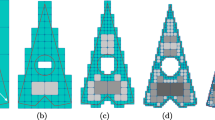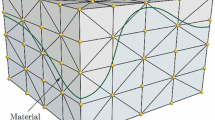Abstract.
Procedures are presented for efficient generation of high-quality unstructured surface and volume grids. The overall procedure is based on the well proven Advancing Front/Local-Reconnection (AFLR) method. The AFLR triangular/tetrahedral grid generation procedure is a combination of automatic point creation, advancing type ideal point placement, and connectivity optimization schemes. A valid grid is maintained throughout the grid generation process. This provides a framework for implementing efficient local search operations using a simple data structure. It also provides a means for smoothly distributing the desired point spacing in the field using a point distribution function. This function is propagated through the field by interpolation from the boundary point spacing or by specified growth normal to the boundaries. Points are generated using either advancing- front type point placement for isotropic elements, advancing-point type point placement for isotropic right angle elements, or advancing-normal type point placement for high-aspect-ratio elements. The connectivity for new points is initially obtained by direct subdivision of the elements that contain them. Local-reconnection with a min-max type (minimize the maximum angle) type criterion is then used to optimize the connectivity. The overall procedure is applied repetitively until a complete field grid is obtained. An advancing-normal procedure is coupled with AFLR for anisotropic tetrahedral and pentahedral element grids. Advancing along prescribed normals from solid boundaries generates layers of anisotropic elements. The points are generated such that either pentahedral or tetrahedral elements with an implied connectivity can be directly recovered. The AFLR surface grid procedure uses an approximate physical space grid to define the surface during grid generation. The mapped space coordinates are mapped back to the actual surface at completion. Multiple surface definition patches are grouped into a single surface. A global mapping transformation is generated for the single surface using the grouped surface connectivity. The mapping coordinates are obtained by solving a coupled set of Laplacian equations. The overall procedure has been applied to a wide variety of configurations. Selected results are presented which demonstrate that high-quality unstructured grids can be efficiently and consistently generated for complex configurations.
Similar content being viewed by others
Author information
Authors and Affiliations
Rights and permissions
About this article
Cite this article
Marcum, D. Efficient Generation of High-Quality Unstructured Surface and Volume Grids. EWC 17, 211–233 (2001). https://doi.org/10.1007/PL00013386
Issue Date:
DOI: https://doi.org/10.1007/PL00013386




